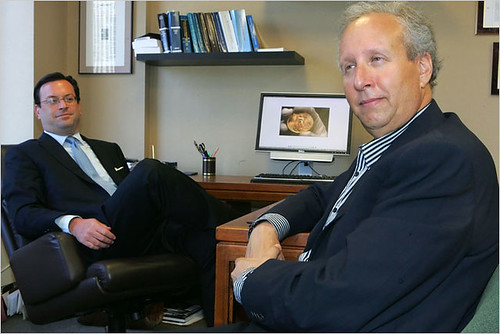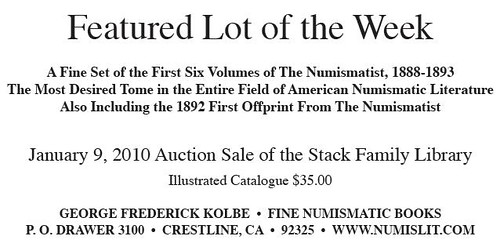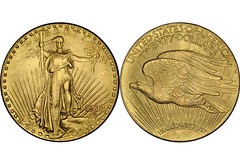
PREV ARTICLE
NEXT ARTICLE
FULL ISSUE
PREV FULL ISSUE
NEW YORK TIMES ARTICLE ON IZZY SWITT'S 1933 DOUBLE EAGLES
Arthur Shippee forwarded this New York Times article about the case of the confiscated 1933 double eagles. The deadline is nearing - soon there should be a new development in the case.
-Editor
Inside the box, opened in 2003, he found an incredibly rare coin, wrapped in a delicate paper sleeve. It was a gold $20 piece with Lady Liberty on one side, a bald eagle flying across the other and, at Liberty's left, the four digits that made it so valuable: 1933. The famous "double eagles" from that year were never officially released by the government. Only a few had ever made their way out of federal vaults, and only one had ever been sold publicly, in 2002. The price: $7.6 million. And there were nine more of them in the safe-deposit box. But after the Langbord family took the coins to the United States Mint to be authenticated in 2004, they got a rude surprise. The Mint said the coins were genuine and kept them. The government claims that they are government property stolen from the Mint, most likely in the 1930s, by Mr. Langbord's grandfather, Israel Switt, a Philadelphia jewelry dealer. The Langbords went to court and recently won an important ruling. A United States District Court judge has given the government until the end of the month either to give back the coins or go back to court to prove that they were in fact stolen by Mr. Switt, a daunting task after three-quarters of a century.

Roy Langbord, right, and his lawyer Barry H. Berke Mr. Langbord, an entertainment industry executive, said he first learned about his family's involvement with the storied coins in 2002 on a flight to Las Vegas, when he read an account of the Farouk coin's odyssey in an advertisement for the auction. He was stunned, he said, to see that the dealer who first procured the coin was his grandfather. When Mr. Langbord got off the plane, he said, he called his mother, Joan Langbord, and asked, "Do we have any more of these?" About a year later, the search turned up the safe-deposit box in Philadelphia. The Secret Service, which polices currency crimes, has argued that all of the double eagles that escaped government control passed through the hands of Mr. Switt, working with a corrupt cashier at the Mint. A Mint spokesman declined to comment on the case because of the litigation. According to a history of the coins by Alison Frankel, a journalist with The American Lawyer, a United States attorney decided not to prosecute Mr. Switt in the mid-1940s, saying the statute of limitations had passed. Ms. Frankel wrote in her 2006 book "Double Eagle: The Epic Story of the World's Most Valuable Coin" that Mr. Switt was "a thoroughly nasty piece of work," and that a dealer who traded with him called him a "gold coin bootlegger" who continued to sell gold coins long after the practice had been prohibited. The book details the government's contention that Mr. Switt worked with a corrupt Mint cashier. Mr. Berke counters such arguments by quoting the Secret Service report on the coins, which explicitly admitted that its investigation "did not conclusively establish when, how or by whom the coins found in circulation were taken from the Philadelphia Mint." The Langbords insist that Mr. Switt, who died in 1990, acquired the coins legitimately before the ban, most likely through a gold-for-gold exchange process used by the Mint in those days. In an interview, Ms. Frankel called Mr. Berke's success in persuading the judge to shift the burden of proof onto the government in the case "quite an amazing accomplishment" that forces the government "to prove a negative — that the coins could not have gotten out legally." Armen Vartian, the general counsel of the Professional Numismatists Guild, agreed. "Nobody can prove conclusively what happened," Mr. Vartian said. "Anybody who has to do that, I think, is going to fail." To read the complete article, see: Rare Coins: Family Treasure or Ill-Gotten Goods? (http://www.nytimes.com/2009/09/16/us/16coin.html)

Wayne Homren, Editor The Numismatic Bibliomania Society is a non-profit organization promoting numismatic literature. See our web site at coinbooks.org. To submit items for publication in The E-Sylum, write to the Editor at this address: whomren@gmail.com To subscribe go to: https://my.binhost.com/lists/listinfo/esylum All Rights Reserved. NBS Home Page Contact the NBS webmaster 
|
 Roy Langbord had guessed that someone in his family might have hidden away a great treasure decades before, but not until his mother had him check a long-neglected safe-deposit box did he realize just how great it was.
Roy Langbord had guessed that someone in his family might have hidden away a great treasure decades before, but not until his mother had him check a long-neglected safe-deposit box did he realize just how great it was.